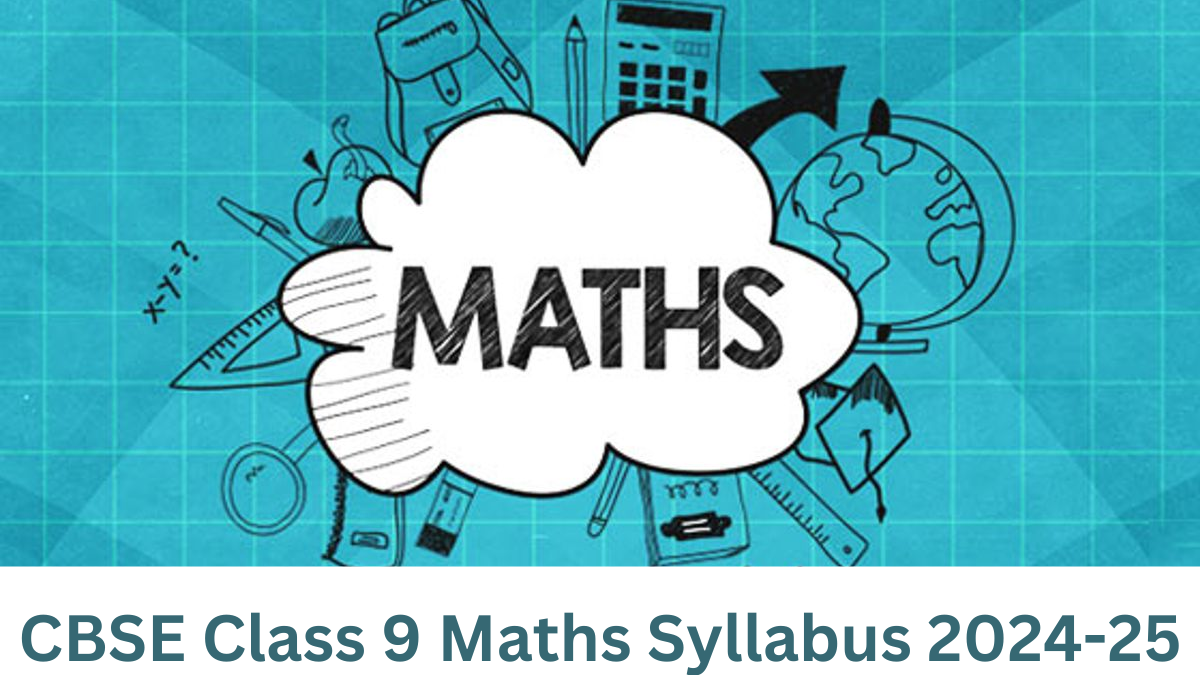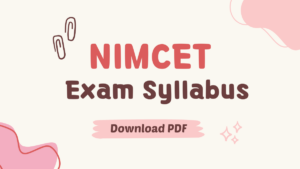For the new academic year, the Central Board of Secondary Education has released the CBSE Class 9 Maths Syllabus 2024-25 on its official website. This updated CBSE Class 9 Maths Syllabus 2025 provides a comprehensive introduction to the course structure, and prescribed material, along with evaluation standards for mathematics. It will assist students in preparing an effective study plan. To facilitate students, here we have provided the unit-wise detailed syllabus of the Class 9 Maths along with PDF.
CBSE Class 9 Maths Syllabus 2024-25
Math is one of the scoring subjects in Class 9, nevertheless, students find it difficult because it covers a variety of concepts and formulas. They can achieve good scores in mathematics if they understand its concepts and practice effectively. To accomplish this, they must cover the complete CBSE Class 9 Maths syllabus 2024-25 and solve all of the questions in the Maths textbook that are related to the concepts.
Furthermore, students must be familiar with the CBSE Class 9 Maths Syllabus 2025 from the start of the academic year so that they can memorize all the chapters and prepare for the exam ahead of time. Go through the page to understand the chapters included in the Class 9 Syllabus with weightage.
Maths Class 9 Syllabus 2025 Marks Distribution
The final question paper for the academic end board examination is to be based on the CBSE Class 9 Maths Syllabus 2024-25 academic year. The CBSE Class 9 Maths syllabus for the upcoming academic year remains virtually unaltered from the previous year. Notably, the same examination pattern persists without substantial changes. Check the unit-wise weightage for CBSE Class 9 Maths:
| Class 9 Mathematics Syllabus 2025- Unitwise Weightage | ||
| S. No. | Name of Unit | Marks |
| 1 | NUMBER SYSTEMS | 10 |
| 2 | ALGEBRA | 20 |
| 3 | COORDINATE GEOMETRY | 4 |
| 4 | GEOMETRY | 27 |
| 5 | MENSURATION | 13 |
| 6 | STATISTICS & PROBABILITY | 6 |
| TOTAL | 80 | |
CBSE Class 9 Maths Syllabus 2025 Unit Wise
The most latest CBSE syllabus 2024-25 of Class 9 Maths comprises a total of 6 units. and each unit discusses different concepts. Let’s take a quick tour of the Units of CBSE Class 9 maths Syllabus given below.
UNIT I: Number System
1. REAL NUMBERS
- Review of representation of natural numbers, integers, and rational numbers on the number
line. Rational numbers as recurring/ terminating decimals. Operations on real numbers. - Examples of non-recurring/non-terminating decimals. Existence of non-rational numbers
(irrational numbers) such as , and their representation on the number line. Explaining that every real number is represented by a unique point on the number line and conversely, viz. every point on the number line represents a unique real number. - Definition of nth root of a real number.
- Rationalization (with precise meaning) of real numbers of the type and (and their combinations) where x and y are natural number and a and b are integers.
- Recall of laws of exponents with integral powers. Rational exponents with positive real bases
(to be done by particular cases, allowing learner to arrive at the general laws.)
UNIT II: Algebra
- POLYNOMIALS (26) Periods
Definition of a polynomial in one variable, with examples and counter examples. Coefficients of a polynomial, terms of a polynomial and zero polynomial. Degree of a polynomial. Constant, linear, quadratic and cubic polynomials. Monomials, binomials, trinomials. Factors and multiples. Zeros of a polynomial. Motivate and State the Remainder Theorem with examples.
Statement and proof of the Factor Theorem. Factorization of ax²+ bx + c, a ≠ 0 where a, b and
c are real numbers, and of cubic polynomials using the Factor Theorem.
Recall of algebraic expressions and identities. Verification of identities:

2. LINEAR EQUATIONS IN TWO VARIABLES
Recall of linear equations in one variable. Introduction to the equation in two variables.
Focus on linear equations of the type ax + by + c=0. Explain that a linear equation in two
variables has infinitely many solutions and justify their being written as ordered pairs of real
numbers, plotting them and showing that they lie on a line.
UNIT III: Coordinate Geometry
COORDINATE GEOMETRY: The Cartesian plane, coordinates of a point, names and terms associated with the coordinate plane, notations.
UNIT IV: GEOMETRY
1. INTRODUCTION TO EUCLID’S GEOMETRY
History – Geometry in India and Euclid’s geometry. Euclid’s method of formalizing observed phenomenon into rigorous Mathematics with definitions, common/obvious notions, axioms/postulates and theorems. The five postulates of Euclid. Showing the relationship between axiom and theorem, for example:
(Axiom) 1. Given two distinct points, there exists one and only one line through them.
(Theorem) 2. (Prove) Two distinct lines cannot have more than one point in common.
2. LINES AND ANGLES
- (Motivate) If a ray stands on a line, then the sum of the two adjacent angles so formed is 180º and the converse.
- (Prove) If two lines intersect, vertically opposite angles are equal.
- (Motivate) Lines that are parallel to a given line are parallel.
3. TRIANGLES
- (Motivate) Two triangles are congruent if any two sides and the included angle of one triangle is equal to any two sides and the included angle of the other triangle (SAS Congruence).
- (Prove) Two triangles are congruent if any two angles and the included side of one triangle is equal to any two angles and the included side of the other triangle (ASA Congruence).
- (Motivate) Two triangles are congruent if the three sides of one triangle are equal to three sides of the other triangle (SSS Congruence).
- (Motivate) Two right triangles are congruent if the hypotenuse and a side of one triangle are equal (respectively) to the hypotenuse and a side of the other triangle. (RHS Congruence)
- (Prove) The angles opposite to equal sides of a triangle are equal.
- (Motivate) The sides opposite to equal angles of a triangle are equal.
4. QUADRILATERALS
- (Prove) The diagonal divides a parallelogram into two congruent triangles.
- (Motivate) In a parallelogram opposite sides are equal, and conversely.
- (Motivate) In a parallelogram opposite angles are equal, and conversely.
- (Motivate) A quadrilateral is a parallelogram if a pair of its opposite sides is parallel and equal.
- (Motivate) In a parallelogram, the diagonals bisect each other and conversely.
- (Motivate) In a triangle, the line segment joining the mid points of any two sides is parallel to the third side and in half of it and (motivate) its converse.
5. CIRCLES
- (Prove) Equal chords of a circle subtend equal angles at the center and (motivate) its converse.
- (Motivate) The perpendicular from the center of a circle to a chord bisects the chord and conversely, the line drawn through the center of a circle to bisect a chord is perpendicular to the chord.
- (Motivate) Equal chords of a circle (or of congruent circles) are equidistant from the center (or their respective centers) and conversely.
- (Prove) The angle subtended by an arc at the center is double the angle subtended by it at any point on the remaining part of the circle.
- (Motivate) Angles in the same segment of a circle are equal.
- (Motivate) If a line segment joining two points subtends equal angle at two other points lying on the same side of the line containing the segment, the four points lie on a circle.
- (Motivate) The sum of either of the pair of the opposite angles of a cyclic quadrilateral is 180° and its converse.
UNIT V: Mensuration
1. AREAS
Area of a triangle using Heron’s formula (without proof)
2. SURFACE AREAS AND VOLUMES
Surface areas and volumes of spheres (including hemispheres) and right circular cones.
UNIT VI: Statistics
STATISTICS; Bar graphs, histograms (with varying base lengths), and frequency polygons.
Class 9 Maths Syllabus 2024-25 PDF Download
To download the official CCBSE Class 9 Maths Syllabus 2024-25, one may visit the official academic portal of the CBSE Board. Students can also download the latest released CBSE Class 9 Maths Syllabus PDF from the link below.










 CUET Commerce Syllabus 2026, Download Su...
CUET Commerce Syllabus 2026, Download Su...
 CUET PG Hindi Syllabus 2026, Download CU...
CUET PG Hindi Syllabus 2026, Download CU...
 NIMCET Syllabus 2026, Download Subject-w...
NIMCET Syllabus 2026, Download Subject-w...














